Microneedling - Everything You Need to Know
Find out everything you wanted to know about microneedling, the ultimate facial which will improve a wide range of skin issues.
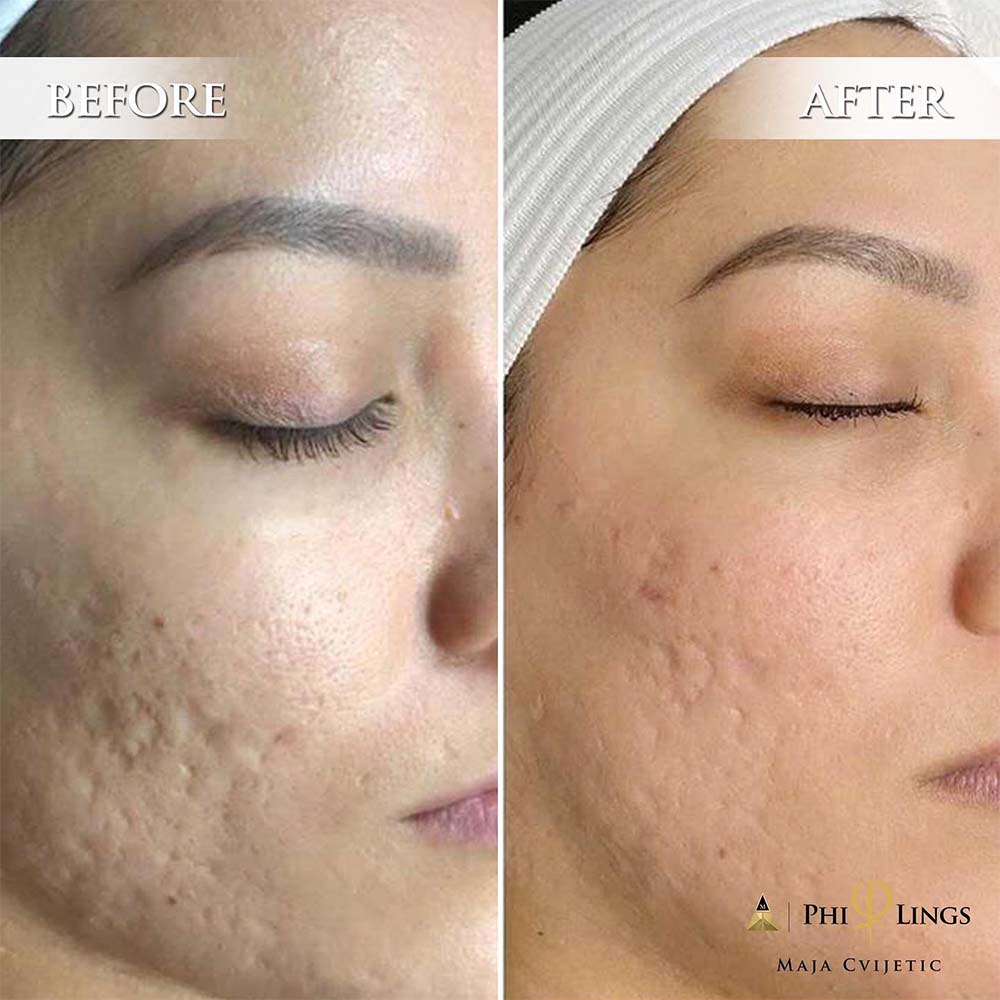
Image source : PMUhub
A spotless complexion is everyone’s no. 1 beauty wish, so it’s no wonder there’s such a wide range of facials available, and new techniques are emerging very often.
But in the sea of options, it’s hard to know what treatments actually work and which don’t. The microneedling facial, however, is something everyone agrees works: dermatologists, estheticians, and satisfied clients.
Microneedling, also known as collagen induction therapy, treats a number of skin issues. It’s a minimally invasive treatment and results can be slow, but they are definitely worth it.
We’re answering all your questions about microneedling.
What Is Microneedling?
Microneedling is a skin resurfacing treatment used for improving the appearance and texture of the skin, and treating imperfections.
It’s become a staple in the beauty industry as a very effective, yet minimally invasive and virtually painless treatment that can be used in most areas of the skin:
- Face
- Scalp
- Body
As the name suggests, it’s a form of skin needling that implies controlled puncturing and affliction of micro-traumas to the skin in order to trigger its regeneration.
It’s often called collagen induction therapy, as this is the primary mechanism that leads to an improvement in skin structure.
What Is Microneedling Good For?
Microneedling is beneficial for a wide range of skin imperfections, but it does have certain restrictions and contraindications. Let’s look into it.
What Issues Can Microneedling Treat?
This is a multipurpose treatment that combines several beneficial mechanisms to battle1:
- Fine lines and wrinkles
- General loss of elasticity (sagging skin)
- Dull skin
- Acne scars
- Other forms of scarring on the face and body
- Stretch marks
- Enlarged pores
- Sun damage and burns
- Hyperpigmentation
- Hair loss
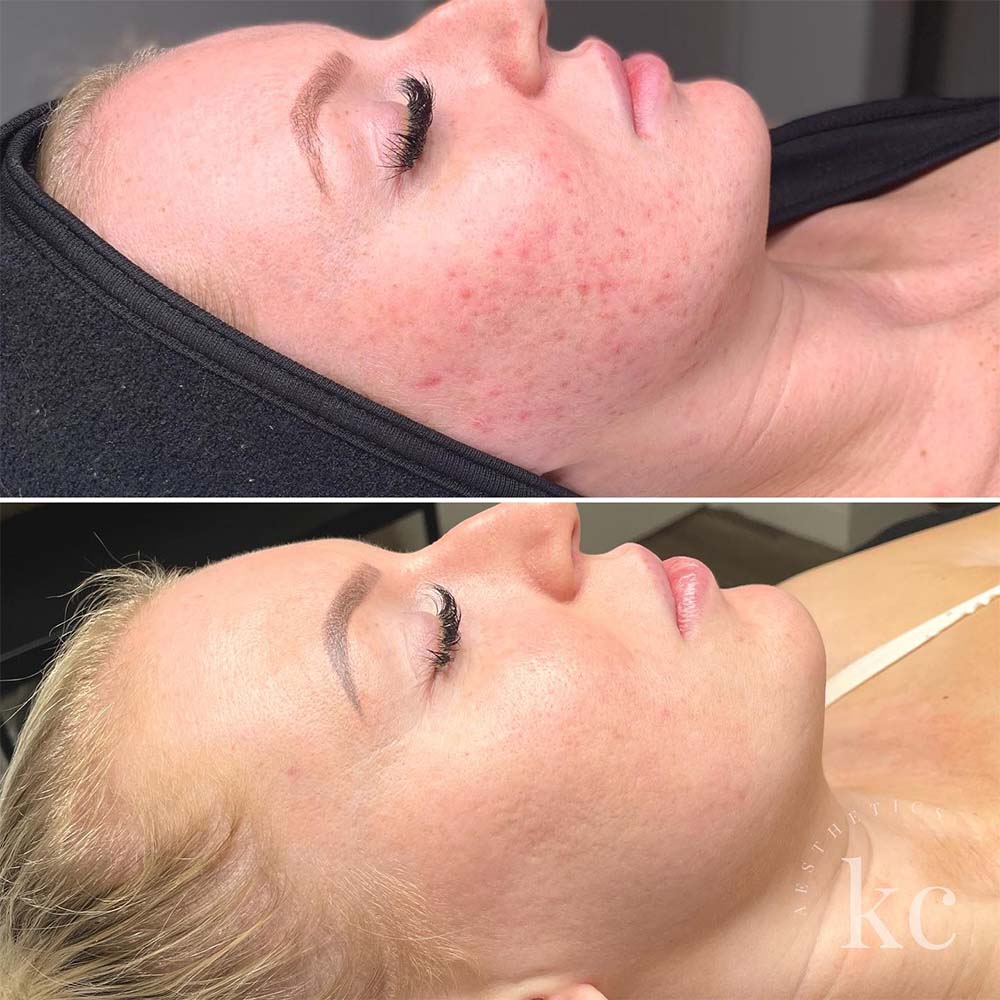
What Issues Can’t Microneedling Treat?
While it is very versatile, this treatment can’t really do much for, or can even worsen, the following:
- Active Rosacea (might help a bit, but it more often makes it worse)
- Eczema
- Psoriasis
- Perioral dermatitis
- Acne breakouts
- Certain types of scars (consult a dermatologist)
- Inflamed skin
- Discolored lips
- Cellulite
Who Is a Candidate for Microneedling?
Anyone dealing with any issues microneedling is known to improve and is safe for, and who doesn’t fall in the category of any of the contraindications listed below.
Who Isn’t a Candidate for Microneedling?
Contraindications for the treatment are:
- Active acne
- Lip herpes or other local skin infection
- Moderate/severe chronic skin diseases like eczema and psoriasis
- Blood clotting or bleeding disorders
- Ongoing blood-thinning medication therapy
- Proneness to keloid scarring
- Ongoing cancer therapy
This list is not final. Consult your esthetician and GP if you have any conditions and let them assess whether you’re a candidate.
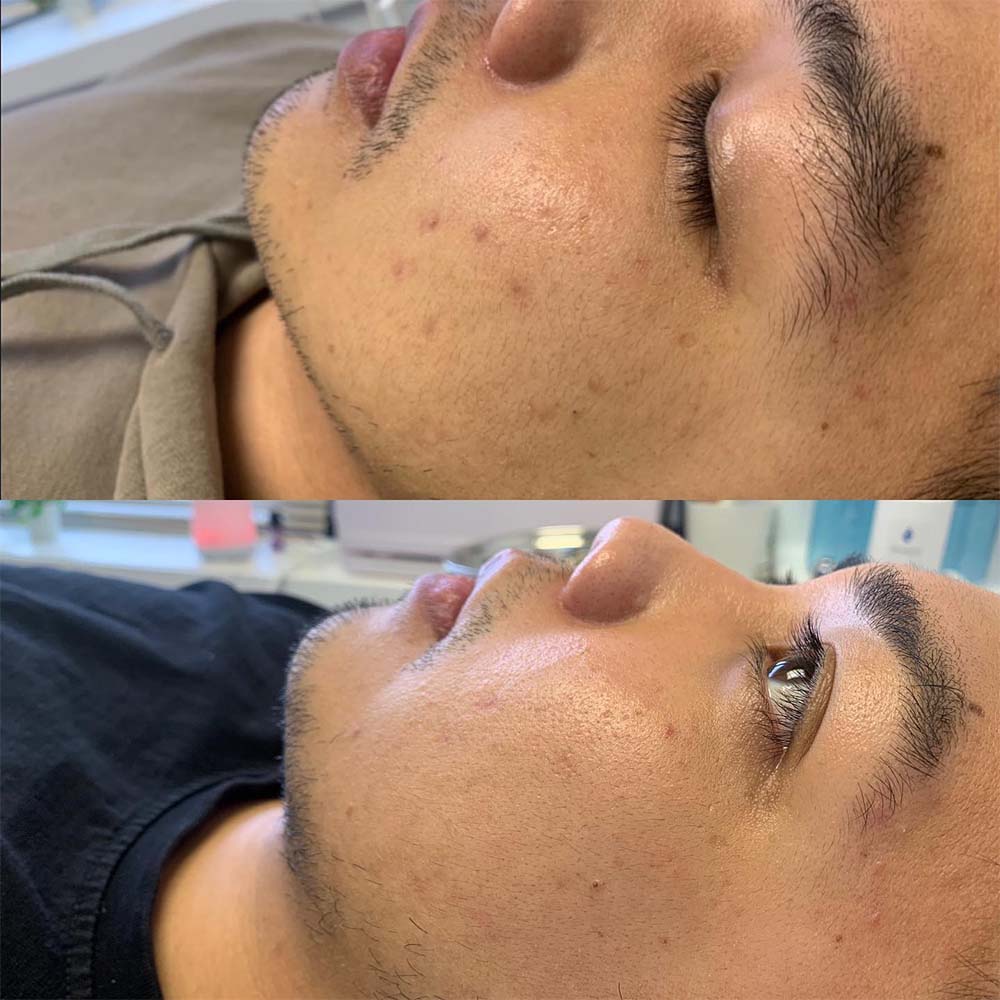
How Is Microneedling Done?
The treatment implies puncturing the skin in countless tiny pokes, reaching live skin cells in the dermis layer of the skin.
These micro-injuries heal into new, improved skin, gradually diminishing the targeted skin issues, and improving the overall state of the treated area.
Okay, And How Exactly Does This Work?
According to the American Academy of Dermatology Association (AAD), when the skin is injured, the body starts a regeneration process, which patches up the injured spot with healthy new skin.
The production of collagen, a protein considered the main building block of the skin, and elastin, which ensures skin elasticity, is triggered. These components are sent to the channels made in the skin, forming new fibers.
The skin needling has to be repeated several times to achieve the so-called collagen remodeling, but collagen production can be increased by up to 400%3.
With the rise in the amount of these components the body itself generates in the skin, more fibers are generated, the structure of the skin is improved, and as a result, so is its appearance.
For extra effects, serums formulated to target the skin issue at hand are applied onto the now broken skin. This form of serum application is much more efficient since the substances penetrate the skin, rather than staying on its surface.
Types of Microneedling Devices
Microneedling can be done either with a derma pen or the derma roller.
Derma Roller
Derma roller is a manual tool that consists of a handle and a drum roller that is covered with needles.
When rolled over the skin, the needles exit at an angle that widens the channel into a crater-like wound. This causes more harm to the skin and it takes a bit longer for the wound to heal.
Plus, the needles’ length can’t be additionally adjusted so going over sensitive areas is slightly more unpleasant compared to derma pen.
You can learn more about microneedling with a derma roller here.
Derma Pen
Derma pen is a pen-shaped electric device that ends in a cluster of needles. The needles are very thin, usually made of stainless steel or titanium, and are essentially stamped into the skin, rather than rolled on top of it.
When compared to the derma roller, this device has a number of advantages – the biggest one being the adjustable needle length and speed. By being able to change penetration depth, pain and chance of infection are significantly reduced.
The dermapen also allows for more precision and can treat areas that are harder to reach due to facial morphology.
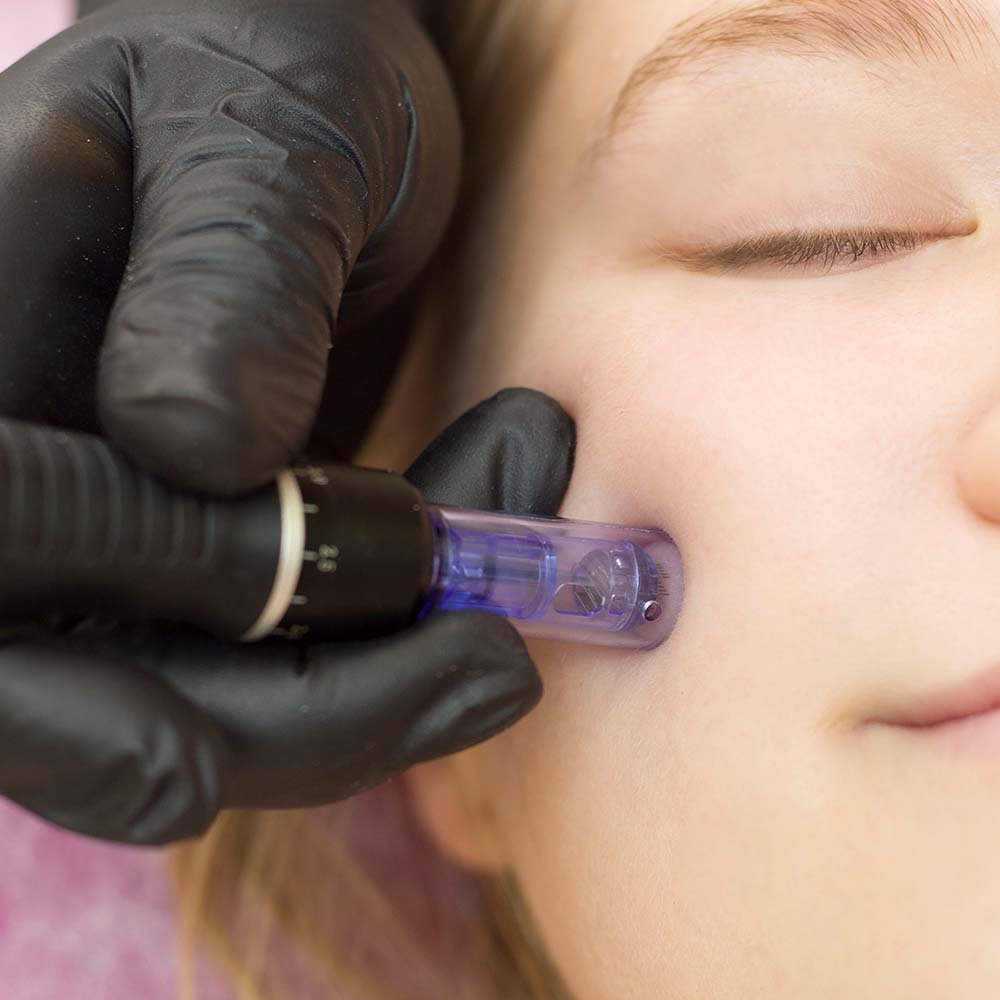
How Deep Should Micorneedling Go?
The needle needs to go in deep enough to trigger the body’s healing process, but not so deep as to damage the skin.
The needle length for microneedling goes from 0.1 mm up to 3 mm. When choosing the depth to which the pins will be penetrating, the technician considers several factors like:
Skin type
Skin texture
Area being treated
And which skin imperfection you want to work on.
Our Microneedling Depth Guide explains the appropriate length based on the area and problem you’re treating.
If microneedling is too aggressive for your skin type or you find it too uncomfortable, you can try nanoneedling, which is very similar, but even less invasive. Learn more about it in our Comprehensive Guide Through Nanoneedling.
What’s the Microneedling Treatment Like?
Here are the steps of a microneedling treatment.
The process is very similar regardless of whether you’re getting a microneedling facial i.e. micro needling face, or the area treated is the scalp or some other part of the body.
Step 1 – Consults and Assessment
Your esthetician will inspect the area to assess the severity of the skin issue and tell you what results you can expect and how many treatments you’ll need.
They will ask you some questions about your medical history to make sure the treatment is safe for you.
Step 2 – Cleaning
The area that will be treated is cleaned with a gentle cleaner that won’t irritate the skin, and disinfected. Since the skin will be broken, the area needs to be clean of any makeup or product residues and sebum, to prevent infection.
Step 3 – Numbing
An anesthetic in the form of a gel or cream is applied onto the area. It will numb the skin and make the treatment painless. It’s left to sit for a certain time, depending on the thickness and sensitivity of the area treated:
Face – 15-20 minutes
Body – 20-30 minutes
Scalp – 30-40 minutes
Some estheticians like to use a plastic seal wrap to lock in the numbing and maximize the effect.
Step 4 – Skin Needling
When the skin is numb, it’s time for the actual microneedling to start.
The technician will go back and forth over the treated area with either a dermapen or a dermaroller. The micro-injuries will cause the skin to turn red, and there might be some pinpoint bleeding – this is totally normal.
The skin needling takes 10-20 minutes, depending on the size of the area treated. It might take longer for the scalp if there’s hair on it.
Step 5 – Mask or Serum
Finally, the tech will apply either a soothing mask or some sort of serum onto the area, to calm it down, nourish it, or for some other specific effect.
Since micro-wounds created during the procedure allow ingredients from topical medications and serums to penetrate deeply into the skin, they have incredible efficiency post-treatment.
Most often the serum is hyaluronic acid, as it’s the most universally efficient ingredient, but there are other options depending on your goal.
Keep in mind though that this is also the time when the skin is extremely sensitive, so using any harsh ingredients can lead to adverse reactions.
In the case of the microneedling facial, they will also apply an SPF, since the area needs to be protected from sun radiation for the rest of the day, at least.
NOTE
The microneedling treatment can be, and often is, combined with some other treatments like PRP, or BB glow.
There’s also a special type of microneedling called radiofrequency (RF) microneedling, which is done with a different device and in a slightly different way.
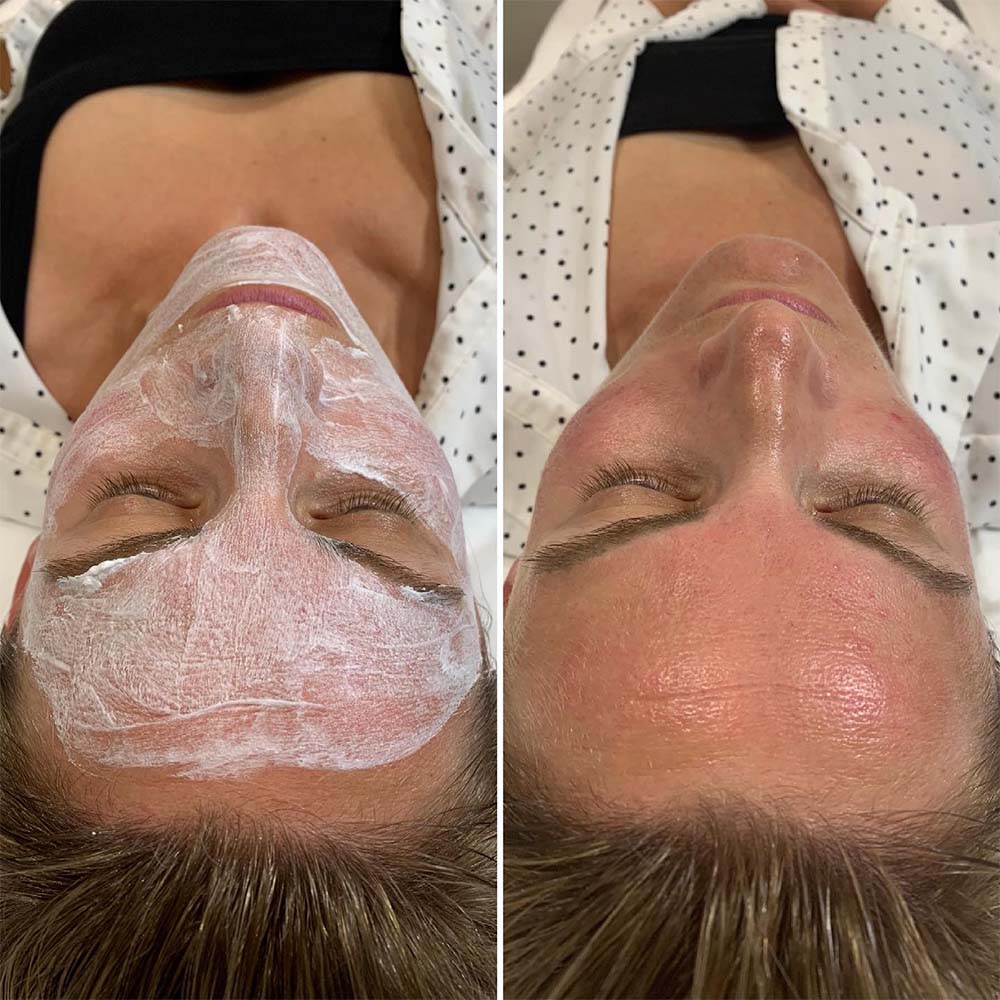
Does Microneedling Hurt?
Micro needling face or body isn’t really painful, since numbing is used to eliminate the pain. But you will likely feel something.
The sensations of microneedling are often described as tingling, scratching, or stinging – sometimes even as general hotness or numbness in the area treated. You may also notice that some areas are more sensitive than others.
Usually, the bonier areas where the skin is thinner tend to hurt a bit more.
But the sensations also depend on the length and thickness of the needle – the thinner the pin, the lesser the discomfort. For this reason, microneedling with a derma pen is generally considered less uncomfortable than dermarolling.
But note that neither should cause any major pain. If you feel any major pain at any moment, tell your esthetician and have them readjust the needle length.
Here’s a more detailed overview of what microneedling feels like.
How Many Sessions Will I Need?
Although a single session may give an improvement, the best results are achieved with 3-6 sessions, depending on the severity of the skin issue.
Collagen remodeling, which is what brings about the improvement in skin texture, is achieved over time and with several sessions. Most clients get a significant improvement within 3 sessions, but some cases require even more treatments.
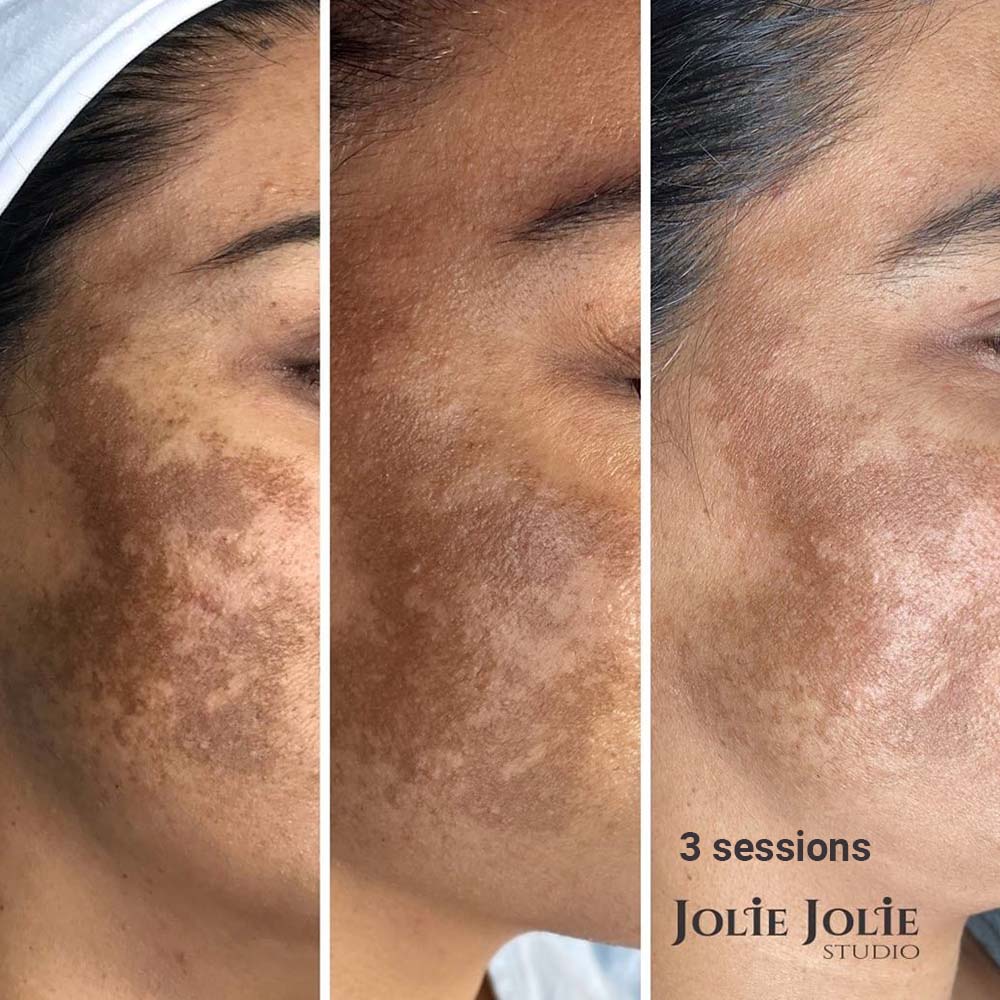
How Long Does the Microneedling Treatment Take?
An average session lasts up to 30 minutes, but numbing may prolong it if it requires 30+ minutes.
How Do I Prepare for the Microneedling Treatment?
You should avoid certain things before the treatment and between sessions to make sure your skin isn’t compromised:
- You need to be off Accutane for 6 months before you get the treatment.
- Avoid laser/IPL treatments for at least 2 weeks before the treatment.
- Don’t expose the area to sunlight at least 2 weeks before the treatment.
- Don’t take blood-thinning meds like ibuprofen or aspirin at least 1 week before the treatment – you’ll bleed more and you might bruise.
- Don’t wax the area or use hair removal creams for 5-7 days before the treatment.
- Don’t use retinol, acids, mechanical and chemical exfoliation, topical antibiotics, and similar harsh products on the area for 5-7 days before the treatment – these thin out the skin and make it more sensitive
- Don’t shave the area on the day of the treatment.
- Don’t take anti-inflammatory meds at least 3 days before the treatment – these can interfere with your natural inflammatory process as a response to the skin needling.
If you’re prone to cold sores, consult your GP and have them prescribe an antiviral med before the treatment to prevent a flare-up.
Microneedling Aftercare
After each microneedling session, you’ll need to pay some special attention to the treated area to make sure it heals properly and comfortably, and to prevent infection:
- Don’t put ice or any cold compress onto the area.
- Don’t pick at, scratch, or rub the area.
- Don’t touch the area with unclean fingers or any other unsterile surface for as long as possible to prevent infection.
- For at least 48 hours, don’t put any makeup on your face. After that, try not to use makeup brushes, or at least wash them before each use.
- For at least 48 hours, try to avoid sweating, so no working out, no hot showers, jacuzzis, saunas or steam baths.
- For 3 days, wash your face with a mild cleanser (your esthetician will probably prescribe a specific one) and warm water. Dry gently by tapping.
- Use the hydrating products your esthetician prescribes according to the schedule they determine. These will soothe skin and aid healing, but also maximize the results of the treatment.
- Wear SPF in the days and weeks after the procedure for as long as possible.
It’s crucial you only use products that your esthetician green-lights. Harsh products could irritate the skin or affect its natural response.
For more detailed aftercare instructions, here’s our Microneedling Aftercare Guide.
Microneedling Healing
In general, healing after microneedling is fast and straightforward.
Is There Any Downtime After Microneedling?
Not really. You can go back to your day right away, as long as you don’t mind the redness.
How Long Does the Skin Need to Heal After Microneedling?
The micro-injuries will close up within a few days after each session depending on treatment intensity, but to make sure the skin’s internal processes have time to roll out, further sessions should be booked at least 3 weeks apart, ideally 4-6 weeks.
What Can I Expect During Microneedling Healing?
The skin will start turning red as soon as halfway through the session, and the healing process starts virtually right afterwards. Here’s what you can expect in the week after the procedure:
Redness
Your skin will be red for several hours after the procedure, it will gradually fade to a pink, and finally subside. Redness is expected for about a day for the microneedling facial, but it can last up to 7 days on different areas of the body.
Tenderness
Some tenderness is expected in the hours after the procedure.
Heat
Most clients report their skin feels hot in the days after the procedure.
Tightness, Dryness and Skin Dehydration
In the days after the treatment, your skin will feel tight and dry, much like a sunburn. You can relieve this discomfort with prescribed moisturizers.
Possible Swelling
You may notice some minor swelling in the treated area, but it should subside within a day or 2.
Possible Bruising
Minor bruising may emerge, but it will go away within 5-7 days.
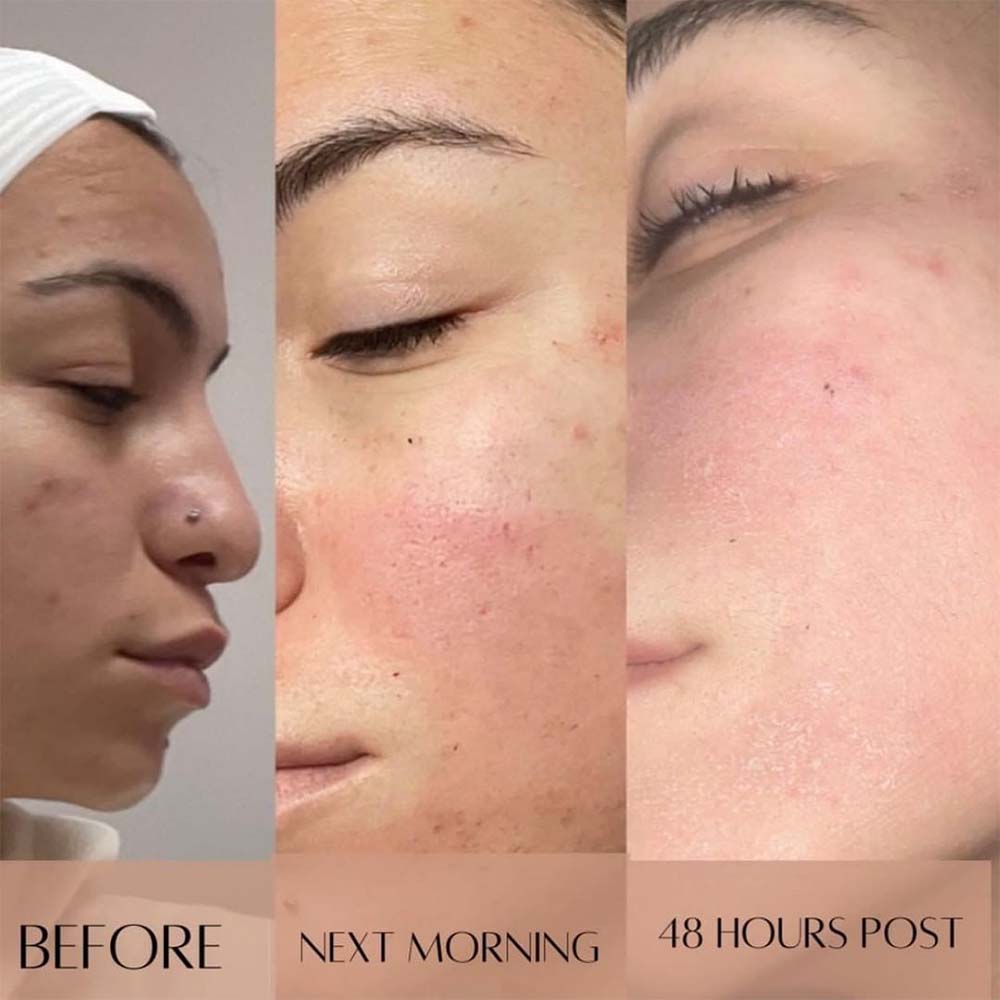
Are Microneedling Effects Immediate?
It’s important to understand that the microneedling effects don’t happen overnight. Collagen remodeling takes time, and the best results are achieved within a few months and with several sessions.
That said, you will notice your skin looking bright and radiant a few days after the treatment. But different effects show up at different times. Skin tightening happens almost immediately.
Diminishing scars takes the most time. Some improvement will happen quite soon, but the final result takes patience.
How Long Will Microneedling Effects Last?
This depends on what you want to achieve.
Brightening, tightening and anti-aging effects can last anywhere from 4 months to a year, but can be maintained with additional sessions. Scalp microneedling also needs to be maintained. Scar reduction can be permanent.
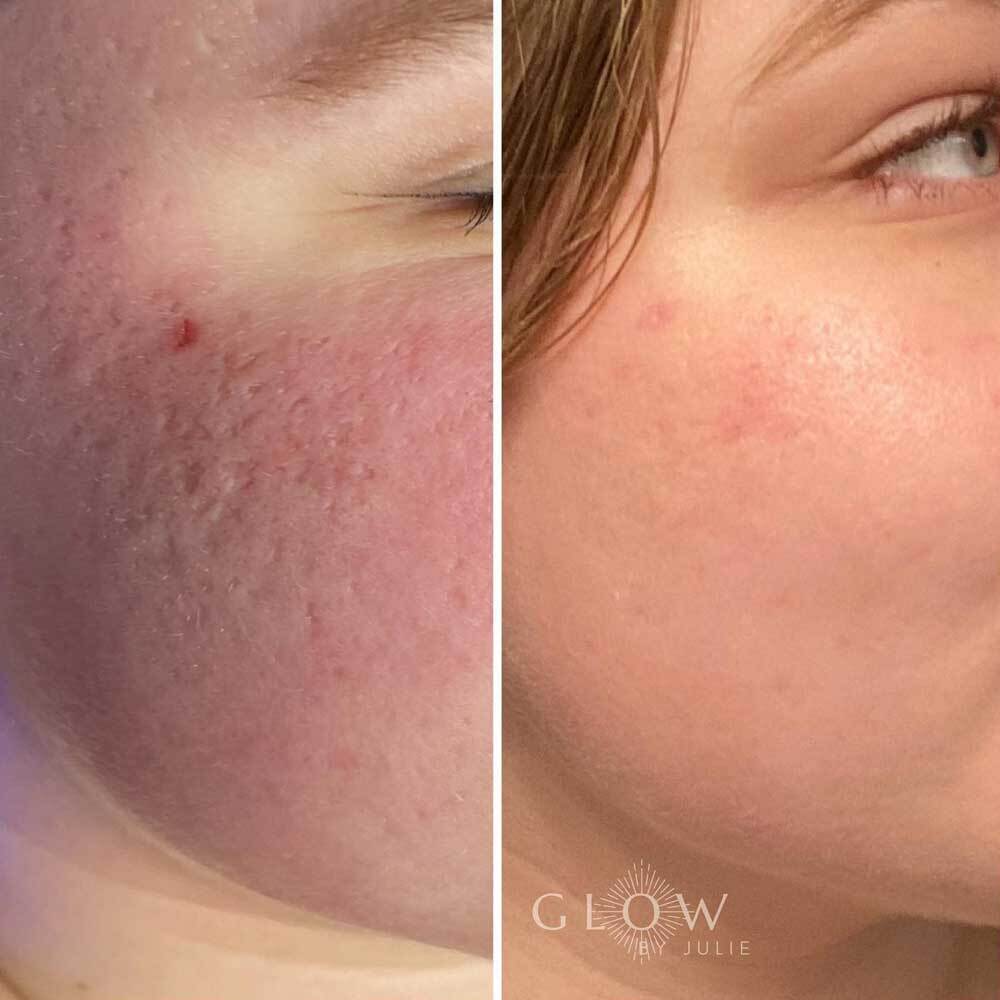
Microneedling Side Effects And Risks
Since skin needling is involved, clients are sometimes worried about the risks and side effects of microneedling. Here’s what you should know.
Is Microneedling Safe?
Yes, as long as you’re a good candidate for it and it’s done right.
You should never go to an uncertified, self-taught esthetician who doesn’t have all the credentials. An improper technique could damage the skin, so do your research and find a technician you can trust.
What Are the Risks of Microneedling?
There are very few risks of microneedling, all of which can be prevented.
Allergies
Since serums and numbing are used during the procedure, there’s a chance of an allergic reaction. That’s why a patch test should always be done before the procedure.
Granulomatous reactions
Skin granulomas are raised, sometimes reddish bumps under the skin. They form as a reaction to infections, inflammation, and irritation.
So it’s not necessarily due to the procedure itself but as a reaction to harmful ingredients in the post-microneedling skincare.
Infection
If the treatment is done in unsterile conditions or the equipment isn’t sterilized properly, or if the area gets contaminated before it heals, you could get an infection.
If you notice the area is very itchy, red for longer than 7 days, or there’s a rash, contact your esthetician or a dermatologist.
Skin damage or scarring
This can happen due to improper technique, or if the length of the needle isn’t suitable for the skin. That’s why you should never go to an untrained, uncertified, or inexperienced esthetician.
Post-inflammatory hyper or hyperpigmentation
Skin discoloration is possible as a result of excessive melanin production triggered by the skin injury. Although a rare occurrence, it’s statistically higher for people with darker skin tones (Fitzpatrick IV, V, VI).
Are There Any Side Effects?
Your skin will go through several stages in the days after the treatment. They come down to the points described in the section Microneedling Healing above, but they are all normal responses and are no cause for concern.
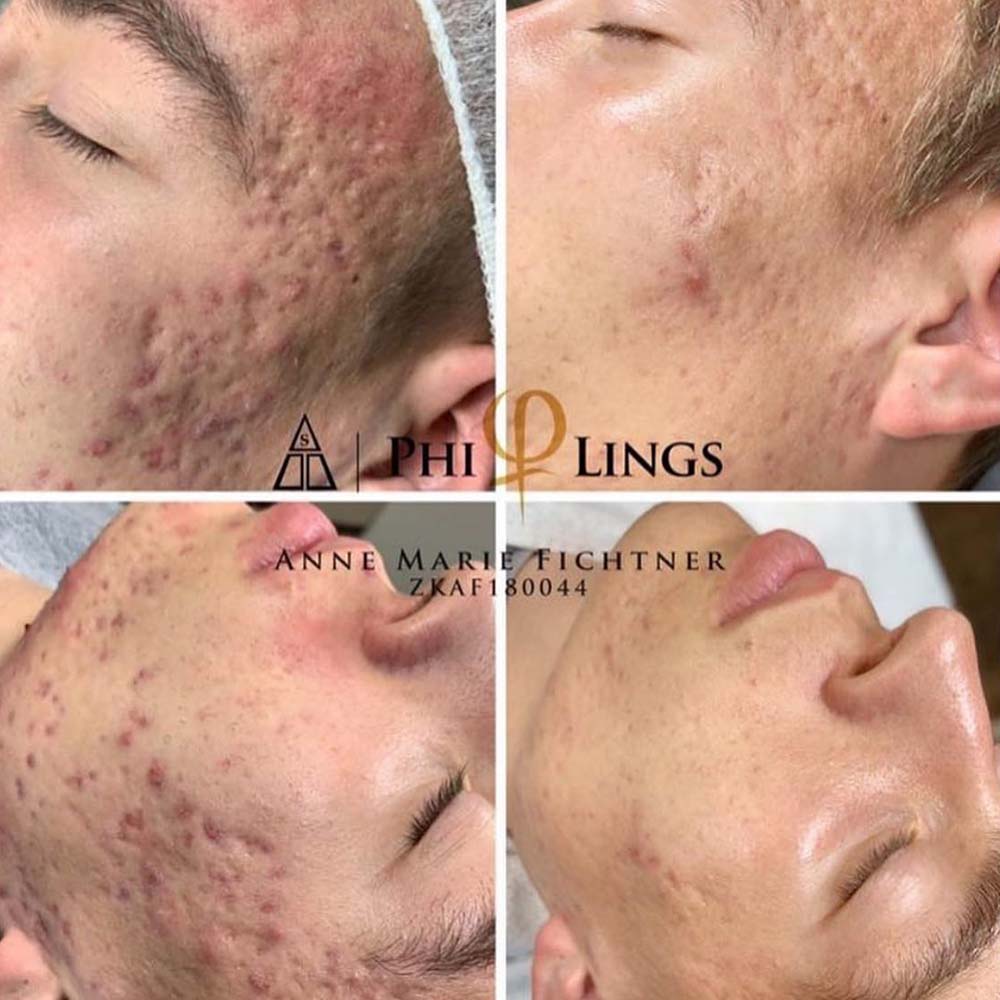
How Much Does Microneedling Cost?
Just like it’s the case with any treatment, the microneedling price varies from one salon to another. The price depends on the area treated, location, exclusivity of the salon, whether microneedling is combined with other treatments or not, etc.
It also depends on the number of sessions you get. Estheticians either charge per treatment, or they offer package deals.
The average price of a single microneedling session is around $200, but it can vary from $100, to as much as $350 per session.
Can I Do Microneedling at Home
Microneedling at home is possible, but the results are limited.
At-home microneedling is supposed to be done with derma rollers you can get over the counter, but tools approved for at-home use have shorter needles, to prevent damage to the skin.
Since you’re not trained, you shouldn’t use professional equipment because you risk overworking the skin and causing potentially permanent damage.
Store-bough derma rollers don’t reach the deep layers of the skin. So you will get some improvement, but not as much as a professional service can give you.
At home microneedling can’t really help when it comes to dealing with a more severe skin concern. But if you’re just looking to improve the appearance of your skin it can help you achieve that.
We’ve covered at-home treatment’s pros and cons in this article.
Often the goal of at-home microneedling sessions isn’t fighting more complex skin concerns at all. Most of the time it’s actually just about increasing product absorption and getting the most out of the serums’ beneficial properties.
Here’s a discussion on what to put on your skin after microneedling.
Check out our Guide to Microneedling at Home to learn how to do this procedure safely by yourself.
NOTE
While we generally don’t encourage this, more and more people are doing derma pen microneedling at home. If you do decide to try this, we have to warn you to be really careful, and get the best microneedling pen available to non-experts.
Microneedling – Main Takeways
Microneedling, or collagen induction therapy, is an efficient way to treat a wide range of skin issues, from the effect of aging, to scars on the face and body, and even thinning hair.
The treatment implies skin needling to trigger the skin’s natural healing through collagen remodeling.
It’s a minimally invasive, quite safe treatment (if done right), but it takes several sessions and a few months to give the best results.
weekly insight into PMU insdustry
Subscribe to our FREE newsletter. 100% good stuff.

support us so we can keep providing you with free education , information and inspiration.
